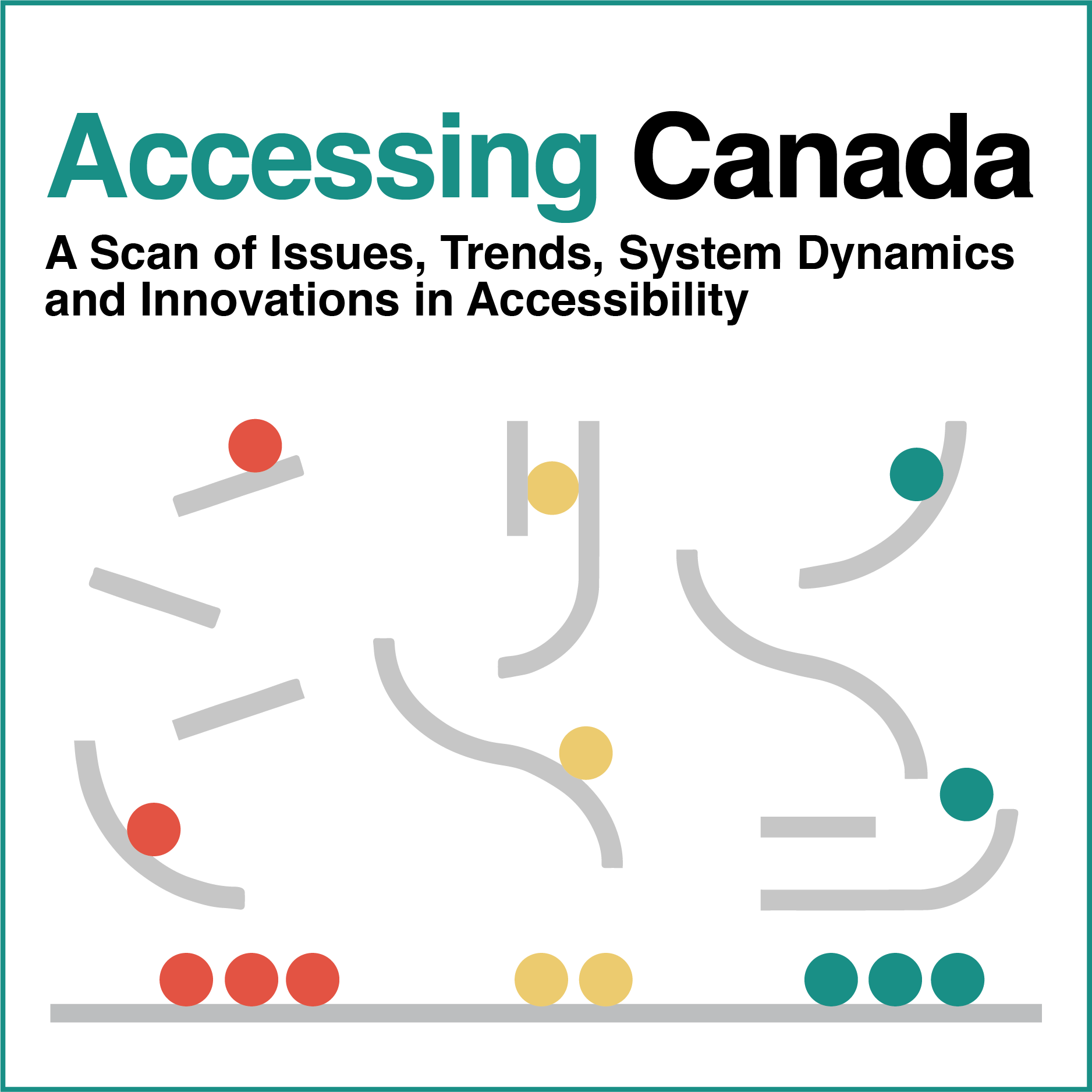Do you know these Canadian facts about accessibility?
Posted March xx, 2024
Here are some facts that stood out for us while writing the report Accessing Canada: A Scan of Issues, Trends, System Dynamics and Innovations in Accessibility.
Canadian Demographics
- Nearly 9 million Canadians aged 16 years and older (or 28% of the population) with a disability (Statistics Canada, 2020).
- There are over 10,000 young people with a disability living in long-term care in Canada (Peter Goffin, 2017).
- Disabilities are more prevalent in women than in men by a small but significant margin, and Indigenous people are more likely to be living with a disability than non-Indigenous Canadians (Amanda Burlock, 2017)
- An aging population will push the prevalence of disability ever higher. In Canada, the population ranges from 13% (ages 15 to 24) to 47% (aged 75 years and over) (Statistics Canada, 2019).
- In 2001, there were two people over 65 for every working-aged person in Canada; By 2031 that ratio will double to four-to-one (Aging and Thriving in the 21st Century, 2021)
- Approximately 50% of Canadian adults with disabilities experience literacy barriers. (Rioux et al., 2003). These barriers can be in either printed or spoken form and include unnecessary words; small or congested fonts; overly baroque, academic or professional jargon, acronyms; and information or services available in online access only. (Fact Sheet, Literacy and Disability by COPIAN).
Accessibilities in COVID-era
- People with disabilities were dying in greater numbers from COVID-19 than non-disabled people, in good measure due to the increased risk of contracting COVID-19 in congregate settings - rehabilitation facilities, state institutions (including prisons), group homes, and care homes. (Ashley Shew, 2020).
- Many people with disabilities during the pandemic were “cut off from the rest of society” with regular reports of overmedication, self-harm, or ill-treatment surfacing (Ciara S. Brennan, 2020).
- “Persons with disabilities have twice the risk of developing conditions such as depression, asthma, diabetes, stroke, have twice the risk of developing conditions such as depression, asthma, diabetes, stroke, obesity or poor oral health (World Health Organization, 2022)
Rising Post-Pandemic Awareness of Accessibilities
- A “Mass Disabling Event”- Long COVID: 10% to 20% of COVID 10 infections result in long COVID (World Health Organization).
- The pandemic also led to higher mortality rates among persons with intellectual disabilities (Williamson et al., 2021)
- Employers have reported an increase in the prevalence of disability in the labour force of nearly 3 per cent (to 21.5%) between 2019 and 2021 mostly due to a rise in reported mental health-related disability (Sophie Harrison, 2023).
- The pandemic also created a teachable moment for disability tech: The pandemic showed us that “Supermarkets, restaurants and pharmacies (even outside cities) can deliver; Remote working, medicine and education are possible for many; and social lives can be rewarding without requiring us to leave home.” (Ashley Shew, 2020)
Anyone could become disabled, and at any time
Indigenous people with disabilities
- Nearly one in three Indigenous People in Canada live with a disability (Government of Canada, 2022)
- 32% of First Nations people living off reserve, 30% of Métis and 19% of Inuit had one or more disabilities that limited them in their daily activities (Hahmann et al., 2019)
- Outside Inuit Nunangat (the four Inuit homeland regions in Canada), the disability rate for Inuit is substantially higher (27 percent compared to 16 percent) (Hahmann et al., 2019)
- Going back to well before contact with the Europeans, many Indigenous nations had sign languages. Perhaps the best well known, still being used today, is Plains Sign Language (PSL). (Indigenous Sign Languages of Canada, 2020)
- Indigenous Disability Canada (IDC) is run out of the BC Aboriginal Network on Disability (BCAND) and hosts a periodic national Indigenous Disability and Wellness Gathering.
- BCAND, formed in 2015 as Canada’s only province-wide Indigenous disability organization (so far, at least), also declared November to be Indigenous Disability Awareness Month. A number of provinces and territories now recognize Indigenous Disability Awareness Month, organizations (e.g. the Assembly of First Nations), as well as many companies.
Indigenous people with disabilities
- Canada’s federal support for people with disabilities is low compared to other countries. (Young, Young Numbers That Cannot Be Ignored, 2022)
- The government has implemented the Disability Inclusion Action Plan and the Accessibility Strategy for the Public Service of Canada (Employment and Social Development Canada (ESDC), 2022)
- The Accessible Canada Act aims to remove barriers and improve accessibility 154
- National AccessAbility Week raises awareness of disability rights and inclusion (Government of Canada, 2023)
- Accommodation is a key concept in disability inclusion 73 (UN CRPD)
- CASDO (Canadian Accessibility Standards Development Organization) and the Accessibility Data Hub are government initiatives to improve accessibility
- Ontario, Manitoba, and Alberta provide the most support per capita, while Newfoundland and Labrador provide the least Disability Data Project, University of Calgary
- Alberta has programs like AISH and PDD to support people with disabilities. Heled, Vertinsky, & Brewer, 2019
- Quebec has a basic income program for those with limited employment capacity
- The Disability Tax Credit and RDSP provide tax relief and savings options for individuals with disabilities
Accessing Canada is the latest in our work in field-scanning and trend-scanning, and seeks to mobilize knowledge from those working to enhance accessibility in many realms to inform a broad general audience. This scan, created in partnership with ATCO, was also an opportunity to reflect on our own practices including the way we create and distribute research. We are pleased to offer multiple versions of the report, including PDF, Ebook, and EPUB, all of which are available on the Accessing Canada Scan webpage.



